Abstract
In this study, AgI/Ag3PO4/WO3 ternary composite photocatalysts with dual Z-scheme heterojunction were fabricated via the in situ loading of Ag3PO4 onto WO3 followed by anion exchange. Compared to single photocatalysts and binary composites, the AgI/Ag3PO4/WO3 composites exhibited enhanced photocatalytic activity in the photodegradation of chlortetracycline hydrochloride (CTC) under visible-light irradiation. Notably, the AAW-40 photocatalyst, which contained an AgI/Ag3PO4 molar ratio of 40%, degraded 75.7% of the CTC within 75 min. Moreover, AAW-40 demonstrated an excellent performance in the cyclic degradation of CTC over four cyclic degradation experiments. The separation and transfer kinetics of the AgI/Ag3PO4/WO3 composite were investigated with photoluminescence spectroscopy, time-resolved photoluminescence spectroscopy, and electrochemical measurements. The improved photocatalytic performance was primarily due to the creation of a silver-bridged dual Z-scheme heterojunction, which facilitated the efficient separation of photoinduced electron–hole pairs, retained the strong reducing capability of electrons in AgI, and ensured the strongly oxidizing nature of the photoexcited holes in WO3. The dual Z-scheme charge-transfer mechanism was further validated using in situ X-ray photoelectron spectroscopy. This study provides a foundation for developing innovative dual Z-scheme photocatalytic systems aimed at the efficient degradation of antibiotics in wastewater.
1. Introduction
Over the past few decades, antibiotics, which are some of the most commonly used drugs in animal husbandry and aquatic farming, have emerged as significant pollutants in aquatic environments owing to their extensive and inappropriate usage [1,2,3]. To tackle these organic pollutants, photocatalytic oxidation, which is a green and environmentally friendly technology for water treatment, can be employed. More specifically, this approach involves the direct and effective harnessing of solar energy as an energy source to activate the semiconductor photocatalyst, generate electron–hole pairs, and trigger a series of redox reactions that oxidize and decompose various organic pollutants in the aqueous medium.
Tungsten trioxide (WO3), which is a typical n-type semiconductor material, has garnered significant interest owing to its remarkable chemical stability, good electrical conductivity, and environmental friendliness [4,5,6,7]. Notably, WO3 has a relatively narrow bandgap compared to similar materials, such as TiO2, ZnO, and NiO, thereby enabling it to absorb visible light. Moreover, it possesses a valence band that can generate highly oxidizing holes, rendering it a popular candidate material in photocatalysis [8,9,10,11]. However, the photocatalytic efficiency of WO3 is severely limited by the high recombination rate of its photogenerated electron–hole pairs, in addition to its low rate of carrier migration, limited light absorption range, and weak electron reduction capability in the conduction band. Consequently, extensive research has been directed towards improving the photocatalytic activity of WO3 through selective elemental doping, morphological control, and heterojunction construction [8]. Among the aforementioned techniques, the formation of semiconductor heterojunctions is an effective means to suppress the recombination of photogenerated carriers within photocatalytic materials while enhancing the efficiency of light absorption. For instance, it has been reported that the type II heterojunction WO3/Bi2WO6 photocatalyst [12], the p-n heterojunction WO3/BiOCl photocatalyst [13], Z-scheme AgI/WO3 [14,15], and the all-solid-state Z-scheme WO3/CDots/CdS [16] effectively promote the separation of photogenerated carriers and significantly improve the photocatalytic performance of WO3 under visible-light irradiation. Furthermore, researchers have enhanced the photocatalytic performance of WO3 by introducing Ag3PO4 with a matching band structure. For example, You et al. [17] prepared a series of Ag3PO4/WO3 photocatalysts using the impregnation method and achieved a significantly higher degradation efficiency than those of the single photocatalysts. However, cyclic degradation experiments revealed that the efficiency of rhodamine B (RhB) degradation by Ag3PO4/WO3 significantly decreased, from 99.9% to 45.6%, after four reuse cycles. In addition, Wang et al. [18] synthesized highly efficient visible light-driven Ag3PO4/WO3 photocatalysts using an in situ precipitation method. Notably, the system exhibited superior degradation performance against methyl blue compared to both Ag3PO4 and WO3 photocatalysts. However, cyclic degradation experiments using methyl blue indicated that the degradation efficiency decreased by 10.6% after four reuse cycles of the Ag3PO4/WO3 photocatalysts. Although the photocatalytic performance of WO3 was significantly enhanced in the binary Ag3PO4/WO3 system, these photocatalysts exhibited poor cycling stability.
With the above considerations in mind, the current study aims to address the limited cycling stability of the Ag3PO4/WO3 composite photocatalyst system, which stems from the susceptibility of Ag3PO4 to photo-corrosion. For this, AgI is incorporated to construct a novel Ag-bridged dual Z-scheme AgI/Ag3PO4/WO3 ternary composite photocatalyst. It is proposed that the matching band structures of Ag3PO4 and WO3, as well as those of Ag3PO4 and AgI, will facilitate the effective separation of electrons and holes through the multilevel transfer of carriers in the AgI/Ag3PO4/WO3 ternary composite photocatalyst system. Moreover, the introduction of AgI, which is poorly soluble in water, into the Ag3PO4/WO3 system has the potential to inhibit the photo-corrosion of Ag3PO4 [19], which could further enhance the photocatalytic degradation activity and cycling stability of the Ag3PO4/WO3 composite photocatalyst. Thus, an Ag3PO4/WO3 composite photocatalyst is synthesized via a hydrothermal approach and AgI/Ag3PO4/WO3 ternary composites containing different component ratios are prepared using the anion exchange method. Furthermore, systematic characterization and analysis are conducted and the photocatalytic degradation of chlortetracycline hydrochloride (CTC) is examined under visible-light irradiation. Finally, a photocatalytic degradation mechanism is proposed for the AgI/Ag3PO4/WO3 ternary composite photocatalyst based on band structure calculations, free-radical capture experiments, and electron spin resonance (ESR) evaluations.
2. Results and Discussion
2.1. Characterization of Photocatalysts
2.1.1. XRD Analysis
Figure 1 presents the XRD patterns of the WO3, Ag3PO4, AgI, Ag3PO4/WO3, AgI/WO3, AAW-20, AAW-40, and AAW-60 samples. The diffraction peaks observed for WO3 and Ag3PO4 correspond to the monoclinic phase WO3 (JCPDS No. 43-1035) and cubic phase Ag3PO4 (JCPDS No. 06-0505) species, respectively. Moreover, the diffraction peaks of WO3 and Ag3PO4 co-exist in the Ag3PO4/WO3 composites. Notably, AgI consists of a mixture of cubic-phase AgI (JCPDS No. 09-0399) and hexagonal-phase AgI (JCPDS No. 09-0374), wherein the peak at 22.3° corresponds to the (100) crystal face of hexagonal-phase AgI. It is observed that the diffraction peaks of both WO3 and AgI are present in the AgI/WO3 composites. Following the introduction of AgI into the Ag3PO4/WO3 composites, the characteristic diffraction peaks of WO3 and Ag3PO4 were observed. Furthermore, weak diffraction peaks attributed to AgI were detected at 39.2° in the AAW-40 and AAW-60 samples. No additional impurity peaks were observed for the AgI/Ag3PO4/WO3 composites, thereby suggesting that no impurities were introduced into the ternary composite material.
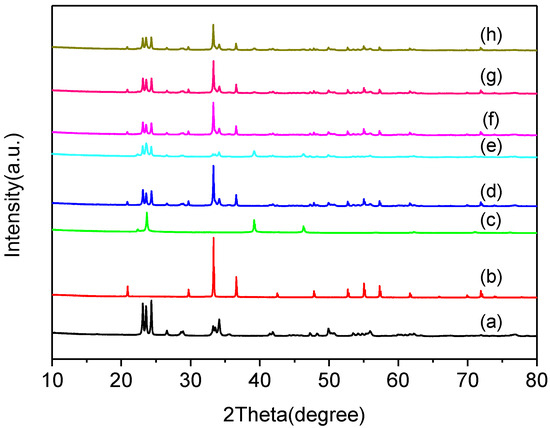
Figure 1.
XRD patterns of the as-prepared: (a) WO3; (b) Ag3PO4; (c) AgI; (d) Ag3PO4/WO3; (e) AgI/WO3; (f) AAW-20; (g) AAW-40; and (h) AAW-60.
2.1.2. SEM Analysis
Figure 2 shows the corresponding SEM images recorded for the various samples and the EDS spectrum of AAW-40. As indicated, WO3 exhibits a smooth sheet-like structure, whereas both Ag3PO4 and AgI feature a spheroidal particle structure. Additionally, the SEM images of the Ag3PO4/WO3 and AgI/WO3 species reveal that spheroidal particles were dispersed on the WO3 surface, while its sheet-like structure remained unaltered. Notably, the surfaces of the Ag3PO4 in the AgI/Ag3PO4/WO3 composites (Figure 2f–h) became rough after the introduction of AgI, and the surface roughness increased with the AgI content. Moreover, the AgI/Ag3PO4 particles were closely bound to the WO3 nanosheets, which was expected to facilitate charge transfer during the photocatalytic degradation process. The EDS spectrum presented in Figure 2i corresponds to the rectangular region of the SEM image of AAW-40 in Figure 2g, thereby unveiling its elemental composition. More specifically, C, O, W, P, Ag, and I were detected, with the C component originating from the conductive adhesive material, and all remaining elements being present in the prepared AAW-40 sample.
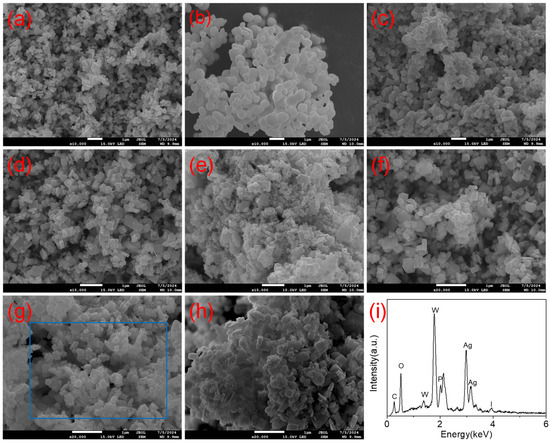
Figure 2.
SEM images of: (a) WO3; (b) Ag3PO4; (c) AgI; (d) Ag3PO4/WO3; (e) AgI/WO3; (f) AAW-20; (g) AAW-40; (h) AAW-60; and (i) EDS spectrum of AAW-40.
2.1.3. TEM Analysis
Figure 3 presents the TEM and high-resolution (HR)TEM images of the as-synthesized AAW-40 composite, revealing the presence of AgI/Ag3PO4 particles on the WO3 surface. Additionally, the HRTEM image revealed three distinct lattice fringes, with the lattice spacings of 0.262 nm and 0.269 nm corresponding to the (202) crystal face of WO3 and the (210) crystal face of Ag3PO4, respectively. Furthermore, the lattice spacing of 0.196 nm was attributed to the (112) face of β-AgI and the (311) face of γ-AgI. The AgI/Ag3PO4 particles were loaded onto the WO3 surface, thereby forming a ternary heterojunction.

Figure 3.
(a) TEM image; and (b) HRTEM image of AAW-40.
2.1.4. XPS Analysis
Figure 4a depicts the XPS survey spectrum of AAW-40, while Figure 4b–f shows the W 4f, Ag 3d, P 2p, I 3d, and O 1s spectra, respectively, for the AAW-40 sample. Notably, signals corresponding to the W, P, Ag, O, and I components were observed in the survey spectrum. Additionally, in the W 4f spectrum (Figure 4b), the peaks at binding energies of 35.59 eV and 37.76 eV correspond to the characteristic peaks of W 4f7/2 and W 4f5/2, respectively [20,21]. Meanwhile, the peaks observed at binding energies of 368.21 eV and 374.21 eV in Figure 4c correspond to the Ag 3d5/2 and Ag 3d2/3 of Ag3PO4 and AgI, respectively [22]. Furthermore, Figure 4d presents the XPS spectrum of P 2p, with the peak binding energy at 132.76 eV corresponding to P5+ of Ag3PO4 [23]. The characteristic I 3d5/2 and I 3d3/2 peaks observed at 619.73 eV and 631.23 eV, respectively, in Figure 4e confirm the formation of the desired AgI/Ag3PO4/WO3 ternary composite [24]. The two peaks observed at 530.51 eV and 532.14 eV in the fitting map for O 1s (Figure 4f), respectively, correspond to lattice oxygen [25] and hydroxyl oxygen components [26].
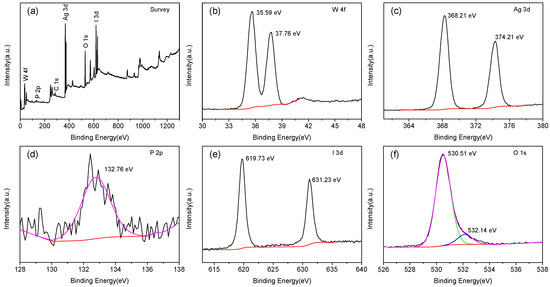
Figure 4.
XPS spectra of AAW-40: (a) survey scan; (b) W 4f; (c) Ag 3d; (d) P 2p; (e) I 3d; and (f) O 1s.
2.1.5. UV–Vis DRS Analysis
The UV–Vis DRS spectra presented in Figure 5a illustrate the light-absorption properties of the photocatalysts. It can be seen that pure WO3 exhibits weaker absorption in the visible-light region than AgI and Ag3PO4. Notably, all AgI/Ag3PO4/WO3 composites demonstrate evident absorption in the visible-light region, enabling their excitation by visible light and use as visible-light photocatalysts. The bandgap energies (Eg) of WO3, Ag3PO4, and AgI were determined using the Kubelka–Munk equation [27,28]:
where α represents the absorption coefficient, h denotes the Planck constant, ν denotes the light frequency, and A is a constant. Additionally, n represents the transition type of the semiconductor, where for direct transition, n = 1, and for indirect transition, n = 4. Since the value of n for WO3 is 4 [29], the bandgap energy of WO3 was estimated to be 2.47 eV based on the plot of (αhv)1/2 versus energy (hv). Furthermore, the n value for both Ag3PO4 and AgI is 1 [30,31], and the bandgap energies of Ag3PO4 and AgI from the plots of (αhv)2 versus energy (hv) were estimated to be 2.41 eV and 2.77 eV, respectively. Subsequently, the valence band edge potentials (EVB) and the conduction band edge potentials (ECB) of WO3, Ag3PO4, and AgI were calculated using the following equations:
αhv = A(hv − Eg)n/2
EVB = X − Ec + 0.5Eg
ECB = EVB − Eg
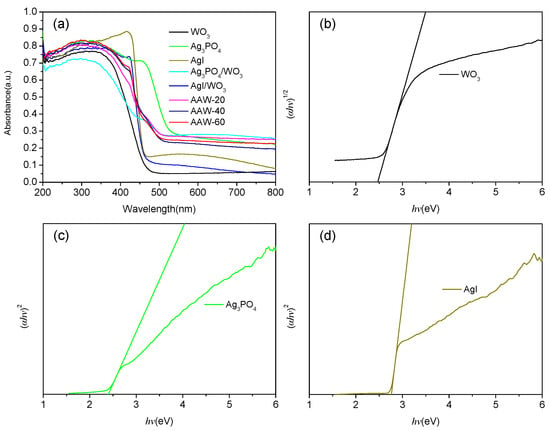
Figure 5.
(a) UV–Vis DRS of as-prepared samples; (b) plots of (αhv)1/2 versus energy (hv) of WO3; Plots of (αhv)2 versus energy (hv) of (c) Ag3PO4 and (d) AgI.
In the aforementioned equations, X denotes the absolute electronegativity of the semiconductor, and Ec represents the energy of free electrons on the hydrogen scale (4.5 eV). The values of X for WO3, Ag3PO4, and AgI are 6.59 eV [32], 5.96 eV [33], and 5.35 eV [34,35]. The EVB and ECB of WO3 are 3.33 eV and 0.86 eV, while those of Ag3PO4 are 2.67 eV and 0.26 eV, respectively. Furthermore, the calculated values of EVB and ECB for AgI are 2.24 eV and −0.53 eV, respectively.
2.2. Photocatalytic Activity and Stability
CTC is a broad-spectrum antibiotic that has found extensive applications in fields such as animal husbandry and medical care. Nevertheless, the abuse of CTC has caused its accumulation in water, gravely threatening environmental and ecological security. Consequently, we carried out research on its degradation by means of photocatalysis. Figure 6a presents the photodegradation curves of the prepared photocatalysts for degrading CTC. Owing to its fast electron and hole recombination and limited visible-light absorption capability, pure WO3 demonstrated the lowest CTC degradation efficiency, reaching only 15.3% after 75 min of visible-light irradiation. Notably, although Ag3PO4, AgI/WO3, and Ag3PO4/WO3 were able to degrade CTC, the ternary AgI/Ag3PO4/WO3 composites exhibited superior degradation efficiencies for CTC compared to the single and binary photocatalysts, with a degradation efficiency exceeding 70% after 75 min of visible-light irradiation. More specifically, AAW-40 exhibited the highest CTC degradation efficiency of 75.7% after 75 min. The superior performances of the ternary AgI/Ag3PO4/WO3 composites were attributed to their dual heterojunction structures, which enabled the efficient separation of photogenerated electrons and holes (c.f., single and binary photocatalytic materials), thereby significantly enhancing the photocatalytic performance. Additionally, the photocatalytic processes performed using these materials followed pseudo-first order kinetics. Figure 6b displays their apparent rate constants (k). It is evident that the k value of AAW-40 was markedly higher than those of WO3, Ag3PO4, Ag3PO4/WO3, and AgI/WO3 samples. Specifically, the k value of AAW-40 is 20.1 times and 1.7 times higher than that of WO3 and Ag3PO4/WO3, respectively. This finding demonstrates that upon the formation of the AgI/Ag3PO4/WO3 composite, the photocatalytic activities of both WO3 and Ag3PO4/WO3 were significantly enhanced. The AAW-40 photocatalyst was further employed in the degradation of RhB solution (20 mg/L, 100 mL). After 30 min of photocatalytic reaction, the degradation efficiency of RhB reached 97.1% (Figure S1). This demonstrates the potential of AAW-40 as an effective photocatalyst for degrading various pollutants.
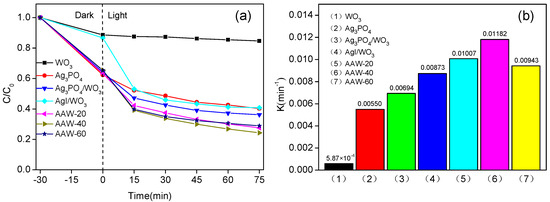
Figure 6.
(a) Photodegradation of CTC with different photocatalysts; and (b) the corresponding apparent rate constants for CTC degradation.
The catalyst reusability was subsequently investigated during cyclic photodegradation experiments of CTC using the AAW-40 photocatalyst. As shown in Figure 7a, the CTC degradation efficiency of AAW-40 decreased only slightly after four degradation cycles, highlighting its excellent repeatability. Additionally, Figure 7b displays the XRD patterns of the AAW-40 photocatalyst after the different-cycle degradation of CTC. It can be seen that a peak corresponding to Ag0 appears in the XRD pattern after the first cycle experiment, indicating the production of metallic Ag during the photodegradation reaction. Upon further comparison of the XRD patterns of AAW-40 after the first and fourth runs (Figure 7b), it is evident that the diffraction intensity of metallic silver did not increase. This portion of Ag0 played a role in resisting corrosion to a certain extent, thereby improving the catalytic stability of the AAW-40 photocatalyst [36]. Furthermore, the SEM image, EDS spectrum, and TEM image of AAW-40 after the cyclic experiments (Figure S2) reveal no discernible alterations in its morphology and elemental composition, which may be attributed to the extremely small size of the generated Ag0 nanoparticles.
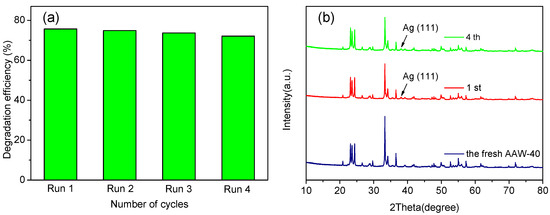
Figure 7.
(a) Reusability of AAW-40 in the photodegradation of CTC; and (b) XRD patterns of the AAW-40 photocatalyst after different-cycle degradation of CTC.
2.3. Photocatalytic Mechanism
The main active species involved in the photodegradation reaction process of CTC over the AAW-40 photocatalyst were investigated through free radical trapping experiments. Isopropyl alcohol (IPA), ethylenediaminetetraacetic acid disodium salt (EDTA-2Na), and 1,4-benzoquinone (BQ) were, respectively, employed as scavengers for hydroxyl radicals (•OH), holes (h+), and superoxide radicals (•O2−). As shown in Figure 8a, the degradation efficiency decreased significantly after adding BQ and EDTA-2Na, suggesting that •O2− and h+ are the predominant active species. Additionally, IPA exerted a certain inhibitory effect on the degradation of CTC, indicating that •OH contributes to the degradation of CTC. As illustrated in Figure 8b, the apparent rate constants in the presence of various scavengers further confirm that •O2− and h+ are the primary active species in our experiments, with h+ being the most critical contributor to the photocatalytic process. The existence of •O2− and •OH in the AAW-40 photocatalytic system was further confirmed by the ESR spin-trapping technique; Figure 9 presents the corresponding spectra. Although no characteristic peak signals corresponding to DMPO-•O2− or DMPO-•OH were observed under dark conditions, distinct signals of DMPO-•O2− (Figure 9a) and DMPO-•OH (Figure 9b) emerged after 20 min of irradiation under visible light, indicating the generation of •O2− and •OH in the photodegradation process of AAW-40. This was highly consistent with the results of the scavenger quenching experiments presented in Figure 8.
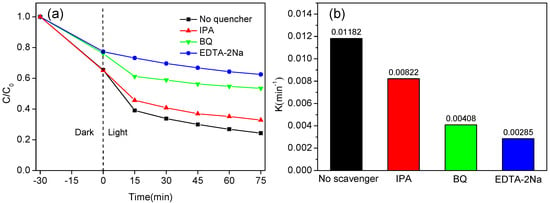
Figure 8.
(a) Trapping experiments performed during the photodegradation of CTC over the AAW-40 photocatalyst; and (b) the corresponding apparent rate constants for CTC degradation.
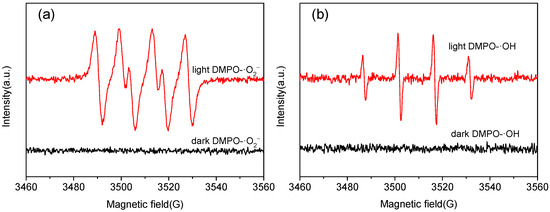
Figure 9.
ESR spectra of superoxide (a) and hydroxyl (b) radicals over the AAW-40 photocatalyst.
PL (photoluminescence) spectroscopy is an effective technique for investigating the separation efficiencies of photogenerated electrons and holes in semiconductors [37]. As depicted in Figure 10a, pure WO3 exhibits strong PL emission at 400–600 nm owing to the rapid recombination of electron–hole pairs. The interfacial contact between the WO3 nanosheets and AgI or Ag3PO4 particles promoted the effective separation of electrons and holes to a certain extent, as evidenced by the weaker PL intensities of AgI/WO3 and Ag3PO4/WO3 compared to that of WO3. It was also observed that the binary composites exhibit higher PL intensities than the ternary AgI/Ag3PO4/WO3 composites, with the AAW-40 heterojunction photocatalyst exhibiting the lowest PL intensity. These results clearly indicate that the introduction of AgI into the Ag3PO4/WO3 photocatalyst effectively enhanced the separation efficiency of photogenerated carriers in this system. Furthermore, the time-resolved PL (TRPL) spectra effectively demonstrate the charge carrier lifetime characteristics of the various photocatalysts, providing a strong basis for inferring their photocatalytic activities. More specifically, as shown in Figure 10b, the average lifetimes of the WO3, Ag3PO4/WO3, and AAW-40 species were determined to be 6.33 ns, 6.51 ns, and 7.13 ns, respectively. Compared with WO3 and Ag3PO4/WO3, the prolonged carrier lifetime of AAW-40 indicates that an effective electron transfer and separation process was achieved in AAW-40 [38]. In addition, the charge separation and transfer properties of the samples were evaluated by photoelectrochemical measurements. Figure 10c shows the transient photocurrent responses of the WO3, Ag3PO4/WO3, and AAW-40 species, wherein the photocurrent intensity reflects the separation efficiency of the photogenerated electron–hole pairs. The photocurrent density of the AAW-40 composite was significantly higher than those of the WO3 and Ag3PO4/WO3 photocatalysts, indicating a superior carrier separation efficiency for AAW-40, which is more conducive to the efficient progress of the photocatalytic reaction. The charge transfer resistance was further evaluated by electrochemical impedance spectroscopy (EIS). Compared to WO3 and Ag3PO4/WO3, the AAW-40 photocatalyst exhibits a smaller arc radius in the EIS Nyquist plots (Figure 10d), indicating that AAW-40 possesses a lower transfer impedance, thus favoring the charge transfer process.
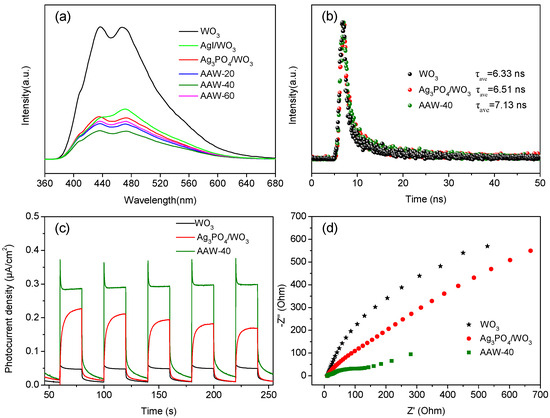
Figure 10.
(a) PL spectra of the representative samples; (b) TRPL spectra, (c) transient photocurrent responses, and (d) EIS Nyquist plots for the WO3, Ag3PO4/WO3 and AAW-40 photocatalysts.
Subsequently, the specific surface areas of the photocatalysts were quantified by the nitrogen adsorption/desorption technique; the corresponding nitrogen adsorption/desorption isotherms are shown in Figure 11. Using the BET approach, the specific surface areas of the WO3, AgI/WO3, Ag3PO4/WO3, and AAW-40 species were determined to be 4.80 m2/g, 4.23 m2/g, 4.14 m2/g, and 3.25 m2/g, respectively. A larger specific surface area typically offers a greater number of photocatalytic reaction sites [39]. However, the specific surface area of the AAW-40 photocatalyst was reduced compared to those of the binary composites and single WO3 nanosheets. Consequently, it can be inferred that the specific surface area is not the primary factor influencing the photocatalytic activity.
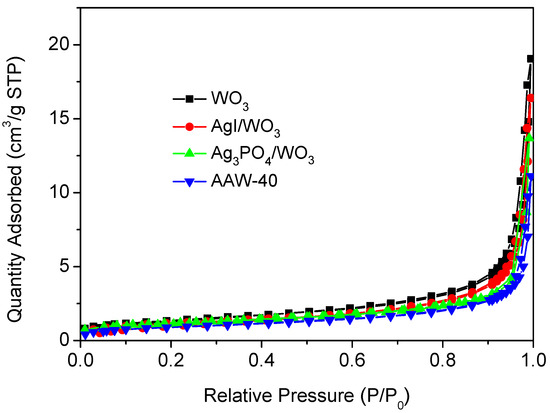
Figure 11.
N2 adsorption/desorption isotherms of the WO3, AgI/WO3, Ag3PO4/WO3, and AAW-40 photocatalysts.
Notably, a type II heterojunction can be formed between AgI, Ag3PO4, and WO3 based on their band positions; Figure 12a depicts the corresponding transfer modes of the photogenerated electrons and holes. When exposed to visible light, AgI, Ag3PO4, and WO3 are excited, generating electrons and holes. As a consequence of the progressively increasing conduction band values of AgI, Ag3PO4, and WO3, along with the successive decline of the valence band values of WO3, Ag3PO4, and AgI, electrons transfer stepwise to the conduction band of WO3 and holes transfer stepwise to the valence band of AgI. However, since the conduction band value of WO3 (0.86 eV vs. NHE) is higher than the redox potential of O2/•O2− (−0.33 eV vs. NHE) [40,41], the electrons in the conduction band of WO3 cannot effectively react with O2 to form •O2−. Moreover, since the EVB of AgI (2.24 eV vs. NHE) is lower than the redox potentials of OH−/•OH (2.40 eV vs. NHE) and H2O/•OH (2.72 eV vs. NHE) [42,43], the holes in the valence band of AgI lack the capacity to oxidize water to form hydroxyl radicals. Therefore, •O2− and •OH cannot be formed in the AgI/Ag3PO4/WO3 system if a type II heterojunction is formed. However, the findings from both the free radical trapping experiments and ESR evaluations confirm the generation of •O2− and •OH during the photocatalytic degradation process. It can therefore be inferred that the photogenerated electrons and holes in the AgI/Ag3PO4/WO3 heterojunction photocatalyst were transferred through other heterojunction patterns. Thus, the dual Z-scheme heterojunction utilizing silver metal as the charge mediator was considered to be more appropriate for clarifying the enhanced photocatalytic mechanism of the AgI/Ag3PO4/WO3 composite [15,44,45]. As shown in Figure 12b, electrons in the conduction band of WO3 flow to the Ag nanoparticles under visible-light irradiation and then recombine with the holes transferred from the valence band of Ag3PO4. Furthermore, the electrons in the conduction band of Ag3PO4 are transferred to the Ag nanoparticles and then recombine with the holes transferred from the valence band of AgI. Moreover, the electrons accumulated in the conduction band of AgI react with O2 to produce •O2−, whereas the holes present in the valence band of WO3 effectively oxidize water molecules to generate •OH or directly oxidize CTC molecules. Via the dual Z-scheme charge transfer pathway, the efficiency of separating photogenerated carriers is greatly improved, which helps to maintain the strong reducing ability of the photoexcited electrons in AgI and the powerful oxidizing capacity of the photoinduced holes in WO3. These results indicate that the enhanced photodegradation behavior of the AgI/Ag3PO4/WO3 photocatalyst can be described by a dual Z-scheme heterojunction mechanism that uses Ag nanoparticles as bridges between the electrons and holes.
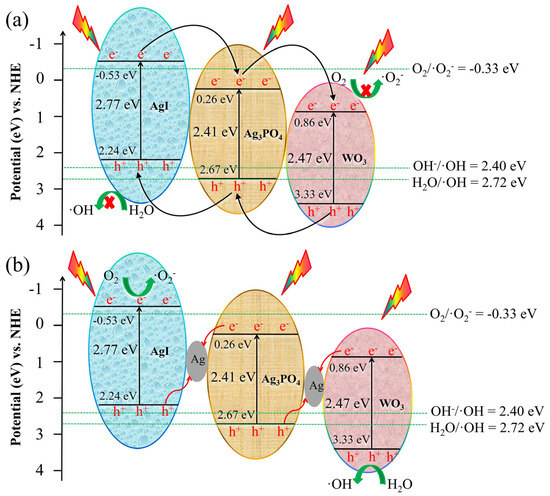
Figure 12.
Schematic representation of the photocatalytic degradation mechanism of the AgI/Ag3PO4/WO3 photocatalyst: (a) Type II and (b) Dual Z-scheme carrier transfer mechanisms.
To further verify the dual Z-scheme charge transfer mechanism during photocatalysis, in situ XPS analysis was conducted under illumination. It is important to highlight that the variation in binding energy (BE) of a specific element directly correlates with changes in its electron density. Specifically, a reduction or enhancement in electron density will result in a positive or negative shift in BE, respectively [46]. As shown in Figure 13, after visible-light irradiation, the P 2p, W 4f, and O 1s peaks recorded for AAW-40 shift towards higher binding energies. In contrast, the I 3d peak shifts to a lower BE, indicating the consumption of electrons in WO3 and Ag3PO4 and the accumulation of electrons in AgI under visible-light irradiation. This result further confirms the occurrence of a dual Z-scheme charge transfer mode in the AAW-40 photocatalytic system, which therefore represents the most likely mechanism responsible for its enhanced photocatalytic efficiency in the photocatalytic degradation of CTC.
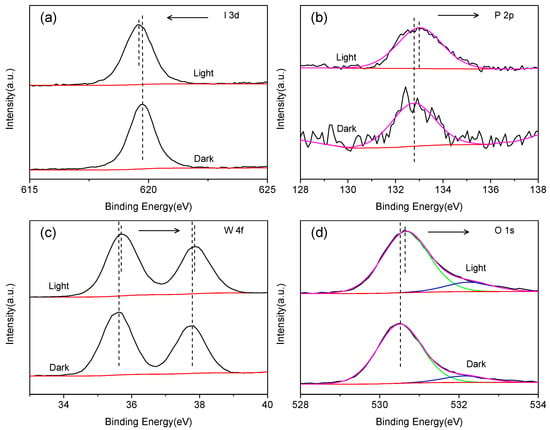
Figure 13.
High-resolution in situ irradiated XPS results for the (a) I 3d, (b) P 2p, (c) W 4f, and (d) O 1s components of the AAW-40 photocatalyst.
2.4. Possible Degradation Pathway of CTC
Qualitative analysis of the model compound CTC and its major degradation products was performed using electrospray ionization quadrupole electrostatic field orbitrap mass spectrometry (ESI-Q-Orbitrap MS) under positive ion mode. As shown in Figure S3, the mass spectra of CTC and its potential intermediates are presented, providing insights into the progression of the reaction (Figure 14). The initial substrate produced a protonated quasi-molecular ion [M + H]+ at m/z 479 in ESI-MS. For the first potential reaction pathway, chlortetracycline underwent dechlorination to form tetracycline with m/z 445. This process follows a complex photochemical mechanism during photolysis. The second possible reaction pathway involved the oxidative cleavage of the C-N bond in the dimethylamino group of chlortetracycline, resulting in a product with m/z 465. This product further underwent demethylation to produce a species at m/z 451, and subsequent oxidative dehydrogenation led to a product at m/z 449. The third potential reaction route was characterized by the oxidative ring-opening of the “D” ring of chlortetracycline, generating a product at m/z 465. This product then underwent successive demethylation steps to yield a product at m/z 435. The fourth possible reaction pathway started with the oxidative ring-opening of the “D” ring of chlortetracycline, giving rise to a product at m/z 495. Subsequently, the oxidative cleavage of the C-N bond in the dimethylamino group occurred, producing a product at m/z 481. This product then underwent decarboxylation to form a product at m/z 437. Further transformations of this product included demethylation and epoxidation to generate a product at m/z 435, as well as oxidative removal of the side chain to produce a product at m/z 366. Additionally, the degradation of the product at m/z 495 also involved decarboxylation to form a product at m/z 451. When the various intermediate products generated during the degradation of chlortetracycline continue to undergo reactions such as oxidation and hydrolysis in the environment, the cyclic structure will be gradually disrupted and opened.
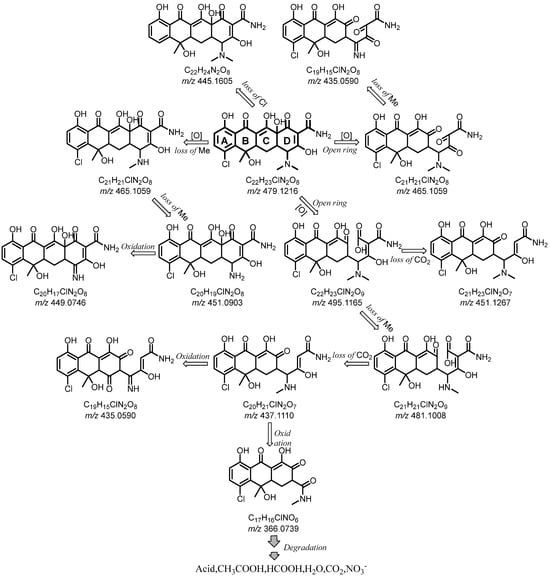
Figure 14.
Possible degradation pathways of CTC.
3. Materials and Methods
3.1. Synthesis of WO3 Nanosheets
In this work, WO3 nanosheets were prepared through a modified version of a previously described hydrothermal approach [20]. To be precise, 10 mL of nitric acid (Sinopharm Chemical Reagent Co., Ltd., Beijing, China) was gradually introduced into 50 mL of deionized water under continuous stirring for 10 min. Separately, 3 mmol of Na2WO4·2H2O (Macklin Biochemical Company, Shanghai, China) was dissolved in 20 mL of deionized water and then slowly added to the nitric acid mixture using an injection pump. The obtained pale-yellow solution was stirred for 1 h, transferred into a Teflon-lined stainless-steel autoclave with a capacity of 150 mL, and heated at 180 °C for 4 h. Once the reaction was complete and the vessel had cooled to ambient temperature, the product was collected via high-speed centrifugation, thoroughly rinsed with deionized water, and finally dried at 60 °C.
3.2. Synthesis of the AgI/Ag3PO4/WO3 Photocatalysts
Silver nitrate (1.02 g) was dissolved in 90 mL of deionized water, and WO3 powder (0.464 g) was suspended in this solution to create suspension A. Separately, Na2HPO4·12H2O (0.716 g) was dissolved in 30 mL of deionized water to form solution B, which was then slowly added to suspension A using an injection pump. The combined mixture was transferred into a 150 mL Teflon-lined stainless-steel autoclave and heated at 120 °C for 6 h. After cooling, the product was collected by centrifugation, washed three times with deionized water, and dried at 60 °C for 12 h to produce the Ag3PO4/WO3 composite photocatalyst. A suspension was then formed by dispersing the prepared Ag3PO4/WO3 (0.50 g) in deionized water (40 mL). Following the addition of an aqueous KI solution (20 mL) via an injection pump, the obtained mixture was stirred for 1 h, then subjected to centrifugation, rinsed three times with deionized water, and finally dried at 60 °C. By adding 0.0239 g, 0.0450 g and 0.0638 g of KI, respectively, products with AgI/Ag3PO4 molar ratios of 20%, 40%, and 60% were obtained and were, respectively, denoted as AAW-20, AAW-40 and AAW-60. Silver nitrate, Na2HPO4·12H2O and KI were all purchased from Sinopharm Chemical Reagent Co., Ltd. (Beijing, China).
3.3. Characterization
The crystal structures, morphologies, and elemental compositions of the as-prepared samples were characterized by X-ray diffraction (XRD, SmartLab, Rigaku, Tokyo, Japan), scanning electron microscopy (SEM, JSM-7200F, JEOL, Tokyo, Japan), energy-dispersive X-ray spectroscopy (EDS, NORAN System 7, Thermo Scientific, Waltham, MA, USA), and transmission electron microscopy (TEM, JEM-2100F, JEOL, Tokyo, Japan). The elemental compositions and valence states of the samples were characterized by X-ray photoelectron spectrometry (XPS, ESCALAB 250XI, Thermo Scientific, Waltham, MA, USA). Additionally, the light absorption performance of each specimen was evaluated using ultraviolet–visible (UV–Vis) diffuse reflectance spectroscopy (DRS, UV-3600Plus, Shimadzu, Kyoto, Japan) over a scan range of 200–800 nm. The PL and TRPL spectra were recorded using a fluorescence spectrometer (FLS1000, Edinburgh Instruments, Edinburgh, UK). Photoelectrochemical measurements were performed on a CHI660E electrochemical workstation (Chenhua Instruments Co., Shanghai, China) using a standard three-electrode system. The BET specific surface areas were determined from the N2 adsorption/desorption isotherms recorded using a Micromeritics ASAP 2460 analyzer (Micromeritics Instrument Co., Norcross, GA, USA).
3.4. Photocatalytic Degradation of CTC
To assess the photocatalytic performance of the different materials, a CTC solution was degraded in a 250 mL double-jacketed beaker, wherein circulating water was supplied using a low-temperature constant-temperature stirring reaction bath at 25 °C. The visible-light irradiation was provided by a 300 W xenon lamp fitted with a 420 nm cut-off filter to block ultraviolet wavelengths. The photocatalyst (40 mg) was added to the CTC solution (20 mg/L, 100 mL). The resulting suspension was stirred in the dark for 30 min prior to switching on the xenon lamp to achieve an adsorption/desorption equilibrium. Once the illumination commenced, a 3 mL sample of the degradation mixture was taken every 15 min and centrifuged to obtain a clear solution. Subsequently, the corresponding concentration at each time point was determined by measuring the absorbance at 367 nm using a spectrophotometer (TU-1901, Beijing Purkinje General Instrument Co., Beijing, China).
4. Conclusions
In conclusion, this study demonstrated the fabrication of Ag-bridged dual Z-scheme AgI/Ag3PO4/WO3 photocatalysts by loading Ag3PO4 onto WO3 nanosheets, followed by anion exchange. Under visible-light irradiation, the resulting ternary AgI/Ag3PO4/WO3 composites demonstrated excellent photocatalytic activities in degrading CTC. Notably, these activities were superior to those of the single photocatalysts and the AgI/WO3 and Ag3PO4/WO3 binary composites. The CTC degradation efficiency of the AAW-40 photocatalyst decreased only slightly after four cycles of degradation, emphasizing its remarkable reusability. Active species trapping experiments and ESR evaluations confirmed that •O2− and h+ were the predominant active species, with •OH also participating in the photodegradation reaction. This finding, based on the determination of the active species and band positions of AgI, Ag3PO4, and WO3, implied the presence of a dual Z-scheme system in which metal Ag acts as a bridge between the photogenerated electrons and holes. This dual Z-scheme charge transfer mechanism significantly suppresses the electron–hole recombination rate, prolongs the charge carrier lifetime, and optimizes the redox potentials of the conduction and valence bands. The obtained results therefore suggest that the as-prepared AgI/Ag3PO4/WO3 composite demonstrates good potential for the purification of antibiotic wastewater.
Supplementary Materials
The following supporting information can be downloaded at: https://www.mdpi.com/article/10.3390/inorganics13070222/s1, Figure S1: photodegradation of RhB by AAW-40 photocatalyst. Figure S2: (a) SEM image and corresponding EDS spectrum of AAW-40 after four cycles; (b) TEM image of AAW-40 after four cycles. Figure S3: mass spectra of CTC degradation intermediates.
Author Contributions
Conceptualization, C.M. and J.T.; methodology, C.M.; formal analysis, C.M., Q.W. and R.M.; investigation, C.M.; resources, C.M., J.T. and Q.L.; data curation, C.M. and J.T.; writing—original draft preparation, C.M.; writing—review and editing, J.T., Q.W., R.M. and Q.L.; visualization, C.M. and J.T.; supervision, C.M., J.T. and Q.L.; project administration, J.T. and Q.L. All authors have read and agreed to the published version of the manuscript.
Funding
The present work was supported by the Scientific and Technological Innovation Programs of Higher Education Institutions in Shanxi (grant number 2023L337), the Fundamental Research Program of Shanxi Province (grant number 202403021222290), and the Taiyuan Institute of Technology Scientific Research Initial Funding (grant number 2023KJ039).
Institutional Review Board Statement
Not applicable.
Informed Consent Statement
Not applicable.
Data Availability Statement
The original contributions presented in this study are included in the article. Further inquiries can be directed to the corresponding author.
Acknowledgments
The author thanks Song Zhengwei from Taiyuan Institute of Technology for providing the scanning electron microscopy testing service.
Conflicts of Interest
The authors declare no conflicts of interest.
References
- Yang, X.; Chen, Z.; Zhao, W.; Liu, C.; Qian, X.; Zhang, M.; Wei, G.; Khan, E.; Ng, Y.H.; Ok, Y.S. Recent advances in photodegradation of antibiotic residues in water. Chem. Eng. J. 2021, 405, 126806. [Google Scholar] [CrossRef] [PubMed]
- Wu, S.; Lin, Y.; Hu, Y.H. Strategies of tuning catalysts for efficient photodegradation of antibiotics in water environments: A review. J. Mater. Chem. A 2021, 9, 2592–2611. [Google Scholar] [CrossRef]
- Zhao, M.; Bai, X.; Zhang, Y.; Yuan, Y.; Sun, J. Enhanced photodegradation of antibiotics based on anoxygenic photosynthetic bacteria and bacterial metabolites: A sustainably green strategy for the removal of high-risk organics from secondary effluent. J. Hazard. Mater. 2022, 430, 128350. [Google Scholar] [CrossRef]
- Liu, X.; Wang, F.; Wang, Q. Nanostructure-based WO3 photoanodes for photoelectrochemical water splitting. Phys. Chem. Chem. Phys. 2012, 14, 7894–7911. [Google Scholar] [CrossRef]
- Shan, Y.; Tang, X.; Shen, D.; Zhou, Z.; Wang, M. A review of tungsten trioxide (WO3)-based materials for antibiotics removal via photocatalysis. Ecotox. Environ. Safe. 2023, 259, 114988. [Google Scholar]
- Adhikari, S.; Mandal, S.; Sarkar, D.; Kim, D.-H.; Madras, G. Kinetics and mechanism of dye adsorption on WO3 nanoparticles. Appl. Surf. Sci. 2017, 420, 472–482. [Google Scholar] [CrossRef]
- Pereira, M.F.G.; Nascimento, M.M.; Cardoso, P.H.N.; Oliveira, C.Y.B.; Tavares, G.F.; Araújo, E.S. Preparation, microstructural characterization and photocatalysis tests of V5+-doped TiO2/WO3 nanocomposites supported on electrospun membranes. Inorganics 2022, 10, 143. [Google Scholar] [CrossRef]
- Dutta, V.; Sharma, S.; Raizada, P.; Thakur, V.K.; Khan, A.A.P.; Saini, V.; Asiri, A.M.; Singh, P. An overview on WO3 based photocatalyst for environmental remediation. J. Environ. Chem. Eng. 2021, 9, 105018. [Google Scholar] [CrossRef]
- Singh, S.A.; Madras, G. Photocatalytic degradation with combustion synthesized WO3 and WO3–TiO2 mixed oxides under UV and visible light. Sep. Purif. Technol. 2013, 105, 79–89. [Google Scholar] [CrossRef]
- Shandilya, P.; Sambyal, S.; Sharma, R.; Mandyal, P.; Fang, B. Properties, optimized morphologies, and advanced strategies for photocatalytic applications of WO3 based photocatalysts. J. Hazard. Mater. 2022, 428, 128218. [Google Scholar] [CrossRef]
- Zhu, W.; Liu, J.; Yu, S.; Zhou, Y.; Yan, X. Ag loaded WO3 nanoplates for efficient photocatalytic degradation of sulfanilamide and their bactericidal effect under visible light irradiation. J. Hazard. Mater. 2016, 318, 407–416. [Google Scholar] [CrossRef]
- Zhao, B.; Shao, N.; Chen, X.; Ma, J.; Gao, Y.; Chen, X. Construction of novel type II heterojunction WO3/Bi2WO6 and Z-scheme heterojunction CdS/Bi2WO6 photocatalysts with significantly enhanced photocatalytic activity for the degradation of rhodamine B and reduction of Cr(VI). Colloids Surf. A 2023, 663, 131072. [Google Scholar] [CrossRef]
- Xiao, Y.; He, Z.; Wang, R.; Tao, X.; Li, B. Synthesis of WO3 nanofibers decorated with BiOCl nanosheets for photocatalytic degradation of organic pollutants under visible light. Colloids Surf. A 2019, 580, 123752. [Google Scholar] [CrossRef]
- Zhi, L.; Zhang, S.; Xu, Y.; Tu, J.; Li, M.; Hu, D.; Liu, J. Controlled growth of AgI nanoparticles on hollow WO3 hierarchical structures to act as Z-scheme photocatalyst for visible-light photocatalysis. J. Colloid Interf. Sci. 2020, 579, 754–765. [Google Scholar] [CrossRef]
- Wang, T.; Quan, W.; Jiang, D.; Chen, L.; Li, D.; Meng, S.; Chen, M. Synthesis of redox-mediator-free direct Z-scheme AgI/WO3 nanocomposite photocatalysts for the degradation of tetracycline with enhanced photocatalytic activity. Chem. Eng. J. 2016, 300, 280–290. [Google Scholar] [CrossRef]
- Zhang, J.; Guo, Y.; Xiong, Y.; Zhou, D.; Dong, S. An environmentally friendly Z-scheme WO3/CDots/CdS heterostructure with remarkable photocatalytic activity and anti-photocorrosion performance. J. Catal. 2017, 356, 1–13. [Google Scholar] [CrossRef]
- You, L.; Gao, M.; Li, T.; Guo, L.; Chen, P.; Liu, M. Investigation of the kinetics and mechanism of Z-scheme Ag3PO4/WO3 p–n junction photocatalysts with enhanced removal efficiency for RhB. New J. Chem. 2019, 43, 17104–17115. [Google Scholar] [CrossRef]
- Wang, C.; Wu, M.; Yan, M.; Shen, H.; Cai, F.; Hu, B.; Shi, W. Enhanced visible-light photocatalytic activity and the mechanism study of WO3 nanosheets coupled with Ag3PO4 nanocrystals. Ceram. Int. 2015, 41, 6784–6792. [Google Scholar] [CrossRef]
- Duan, Y.; Deng, L.; Shi, Z.; Zhu, L.; Li, G. Assembly of graphene on Ag3PO4/AgI for effective degradation of carbamazepine under Visible-light irradiation: Mechanism and degradation pathways. Chem. Eng. J. 2019, 359, 1379–1390. [Google Scholar] [CrossRef]
- Yan, M.; Wu, Y.; Zhu, F.; Hua, Y.; Shi, W. The fabrication of a novel Ag3VO4/WO3 heterojunction with enhanced visible light efficiency in the photocatalytic degradation of TC. Phys. Chem. Chem. Phys. 2016, 18, 3308–3315. [Google Scholar] [CrossRef]
- Tang, M.; Ao, Y.; Wang, C.; Wang, P. Rationally constructing of a novel dual Z-scheme composite photocatalyst with significantly enhanced performance for neonicotinoid degradation under visible light irradiation. Appl. Catal. B 2020, 270, 118918. [Google Scholar] [CrossRef]
- Tang, M.; Ao, Y.; Wang, C.; Wang, P. Facile synthesis of dual Z-scheme g-C3N4/Ag3PO4/AgI composite photocatalysts with enhanced performance for the degradation of a typical neonicotinoid pesticide. Appl. Catal. B 2020, 268, 118395. [Google Scholar] [CrossRef]
- Lv, J.; Dai, K.; Lu, L.; Geng, L.; Liang, C.; Zhu, G. Cu/Ag/Ag3PO4 ternary composite: A hybrid alloy-semiconductor heterojunction structure with visible light photocatalytic properties. J. Alloy. Compd. 2016, 682, 778–784. [Google Scholar] [CrossRef]
- Huang, H.; Li, Y.X.; Wang, H.L.; Jiang, W.F. In situ fabrication of ultrathin-g-C3N4/AgI heterojunctions with improved catalytic performance for photodegrading rhodamine B solution. Appl. Surf. Sci. 2021, 538, 148132. [Google Scholar] [CrossRef]
- Shen, Y.; Li, T.; Zhong, X.; Li, G.; Li, A.; Wei, D.; Zhang, Y.; Wei, K. Ppb-level NO2 sensing properties of Au-doped WO3 nanosheets synthesized from a low-grade scheelite concentrate. Vacuum 2020, 172, 109036. [Google Scholar] [CrossRef]
- Bi, W.; Huang, L.; Akbar, N.; Wu, Y. Interfacial ionic transport in natural palygorskite-Na0.60CoO2 nanocomposite mineral materials. Int. J. Hydrog. Energ. 2022, 47, 24439–24451. [Google Scholar] [CrossRef]
- Bulter, M.A. Photoelectrolysis and physical properties of the semiconducting electrode WO2. J. Appl. Phys. 1977, 48, 1914–1920. [Google Scholar]
- Zeng, J.; Wang, H.; Zhang, Y.; Zhu, M.K.; Yan, H. Hydrothermal synthesis and photocatalytic properties of pyrochlore La2Sn2O7 nanocubes. J. Phys. Chem. C 2007, 111, 11879–11887. [Google Scholar] [CrossRef]
- Luo, J.; Zhou, X.; Ma, L.; Ning, X.; Zhan, L.; Xu, X.; Xu, L.; Zhang, L.; Ruan, H.; Zhang, Z. Fabrication of WO3/Ag2CrO4 composites with enhanced visible-light photodegradation towards methyl orange. Adv. Powder Technol. 2017, 28, 1018–1027. [Google Scholar] [CrossRef]
- Chen, X.J.; Dai, Y.Z.; Wang, X.Y.; Guo, J.; Liu, T.H.; Li, F.F. Synthesis and characterization of Ag3PO4 immobilized with graphene oxide (GO) for enhanced photocatalytic activity and stability over 2,4-dichlorophenol under visible light irradiation. J. Hazard. Mater. 2015, 292, 9–18. [Google Scholar] [CrossRef]
- Wu, D.; Long, M. Realizing visible-light-induced self-cleaning property of cotton through coating N-TiO2 film and loading AgI particles. ACS Appl. Mater. Interfaces 2011, 3, 4770–4774. [Google Scholar] [CrossRef]
- Shi, S.; Teng, F.; Hao, W.; Gu, W.; Yang, Z.; Zhao, F. Influence of crystal water on crystal structure, electronic structure, band structure, and charge separation of WO3·2H2O nanosheets. Inorg. Chem. 2019, 58, 9161–9168. [Google Scholar] [CrossRef]
- Chen, X.; Dai, Y.; Guo, J.; Liu, T.; Wang, X. Novel magnetically separable reduced graphene oxide (RGO)/ZnFe2O4/Ag3PO4 nanocomposites for enhanced photocatalytic performance toward 2,4-Dichlorophenol under visible light. Ind. Eng. Chem. Res. 2016, 55, 568–578. [Google Scholar] [CrossRef]
- Chen, L.; Jiang, D.; He, T.; Wu, Z.; Chen, M. In-situ ion exchange synthesis of hierarchical AgI/BiOI microsphere photocatalyst with enhanced photocatalytic properties. CrystEngComm 2013, 15, 7556–7563. [Google Scholar] [CrossRef]
- Teng, P.; Li, Z.; Gao, S.; Li, K.; Copner, N.; Zhihai, L.; Yang, X. Flexible PAN-BiOI-AgI heterojunction nanofiber and the photocatalytic degradation property. Opt. Mater. Express 2022, 12, 1031–1042. [Google Scholar] [CrossRef]
- Wen, X.J.; Niu, C.G.; Guo, H.; Zhang, L.; Liang, C.; Zeng, G.M. Photocatalytic degradation of levofloxacin by ternary Ag2CO3/CeO2/AgBr photocatalyst under visible-light irradiation: Degradation pathways, mineralization ability, and an accelerated interfacial charge transfer process study. J. Catal. 2018, 358, 211–223. [Google Scholar] [CrossRef]
- Le, S.; Jiang, T.; Li, Y.; Zhao, Q.; Li, Y.; Fang, W.; Gong, M. Highly efficient visible-light-driven mesoporous graphitic carbon nitride/ZnO nanocomposite photocatalysts. Appl. Catal. B 2017, 200, 601–610. [Google Scholar] [CrossRef]
- Luo, J.; Chen, J.; Chen, X.; Ning, X.; Zhan, L.; Zhou, X. Construction of cerium oxide nanoparticles immobilized on the surface of zinc vanadate nanoflowers for accelerated photocatalytic degradation of tetracycline under visible light irradiation. J. Colloid Interface Sci. 2021, 587, 831–844. [Google Scholar] [CrossRef]
- Muhmood, T.; Xia, M.; Lei, W.; Wang, F. Erection of duct-like graphitic carbon nitride with enhanced photocatalytic activity for ACB photodegradation. J. Phys. D Appl. Phys. 2018, 51, 065501. [Google Scholar] [CrossRef]
- Ling, Q.; Kuang, P.; Zhong, X.; Hu, B. Adsorption-photoreduction behaviors and mechanisms of layered double hydroxide loaded on uranium(VI) removal. Dalton Trans. 2023, 52, 8247–8261. [Google Scholar] [CrossRef]
- Kang, F.; Sheng, G.; Yang, X.; Zhang, Y. Fabrication of two-dimensional Bi2MoO6 nanosheet-decorated Bi2MoO6/Bi4O5Br2 type II heterojunction and the enhanced photocatalytic degradation of antibiotics. Inorganics 2024, 12, 289. [Google Scholar] [CrossRef]
- Jiang, L.; Yuan, X.; Zeng, G.; Liang, J.; Chen, X.; Yu, H.; Wang, H.; Wu, Z.; Zhang, J.; Xiong, T. In-situ synthesis of direct solid-state dual Z-scheme WO3/g-C3N4/Bi2O3 photocatalyst for the degradation of refractory pollutant. Appl. Catal. B 2018, 227, 376–385. [Google Scholar] [CrossRef]
- Xue, W.; Huang, D.; Li, J.; Zeng, G.; Deng, R.; Yang, Y.; Chen, S.; Li, Z.; Gong, X.; Li, B. Assembly of AgI nanoparticles and ultrathin g-C3N4 nanosheets codecorated Bi2WO6 direct dual Z-scheme photocatalyst: An efficient, sustainable and heterogeneous catalyst with enhanced photocatalytic performance. Chem. Eng. J. 2019, 373, 1144–1157. [Google Scholar] [CrossRef]
- Arif, M.; Mahsud, A.; Ali, A.; Liao, S.; Xia, J.; Xiao, H.; Azam, M.; Muhmood, T.; Lu, Z.; Chen, Y. Unraveling the synergy of interface engineering α-MnO2/Bi2WO6 heterostructures and defective active sites for superdurable photocatalysis: Mechanistic insights into charge separation/transfer. Chem. Eng. J. 2023, 475, 146458. [Google Scholar] [CrossRef]
- Muhmood, T.; Cai, Z.; Lin, S.; Xiao, J.; Hu, X.; Ahmad, F. Graphene/graphitic carbon nitride decorated with AgBr to boost photoelectrochemical performance with enhanced catalytic ability. Nanotechnology 2020, 31, 505602. [Google Scholar] [CrossRef]
- Wang, L.; Cheng, B.; Zhang, L.; Yu, J. In situ irradiated XPS investigation on S-Scheme TiO2@ZnIn2S4 photocatalyst for efficient photocatalytic CO2 reduction. Small 2021, 17, 2103447. [Google Scholar] [CrossRef]
Disclaimer/Publisher’s Note: The statements, opinions and data contained in all publications are solely those of the individual author(s) and contributor(s) and not of MDPI and/or the editor(s). MDPI and/or the editor(s) disclaim responsibility for any injury to people or property resulting from any ideas, methods, instructions or products referred to in the content. |
© 2025 by the authors. Licensee MDPI, Basel, Switzerland. This article is an open access article distributed under the terms and conditions of the Creative Commons Attribution (CC BY) license (https://creativecommons.org/licenses/by/4.0/).